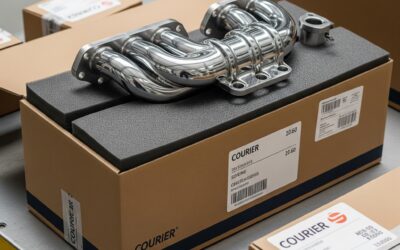Have you ever dreaded dealing with the mountain of paperwork that goes along with managing courier services? The endless purchase orders, invoices, receipts, bills of lading, route planning and tracking, manifests, and other documents can quickly become overwhelming. Trying to manage it all manually—with spreadsheets, folders, and sticky notes, means higher chances of error and headaches.
That’s where courier management software-also, called last-mile delivery software, can help. This type of software has the potential to transform your entire business. It does this by digitizing and streamlining your most critical processes into one central system. The software saves you and your team valuable time and money, while also improving service for your customers.
Read on as we tell you more about delivery management software, its key features, benefits, and how it can help improve your courier delivery business.

Key Features of Courier Management Software
Courier software comes with many features that are helpful for your business.
Here are the top features:
Order and Dispatch Management
Effortlessly manage your entire order process from one centralized place. You can easily update the order delivery process, assign orders to couriers, and schedule and reschedule order deliveries. Also, calculate delivery fees automatically based on location, weight, and other factors. A dispatch board provides visibility into all active orders, so you can optimize routes and resource allocation.
Tracking and Visibility
Real-time order tracking by courier delivery software keeps customers informed every step of the way. Customers can track orders directly through a web portal or via email and SMS updates. For you, comprehensive reports and dashboards provide insight into order progress, bottlenecks, and any disruptions. GPS tracking of vehicles tracks the location of your entire fleet, increasing operational efficiency.
Customer Management
You can organize and manage all your clients from account profiles within the software. This software allows you to gain insight into an individual customer’s order history. You can also get their payment details, preferred contact methods, special requests, automated customer notifications, and other notes to personalize service and build loyalty. Automatically assign new orders to the preferred couriers of VIP customers.
Inventory Management
Gain real-time visibility into inventory levels across warehouse and vehicle locations. Automatically decrement inventory levels as orders are fulfilled to prevent overselling. Set reorder thresholds to maintain optimal stock levels. You can also receive alerts when critical inventory is running low, so you can restock on time.
Reporting and Analytics
Data-driven insights power better decision-making. Comprehensive reports on order volumes, fulfillment times, delivery confirmation, delays, customer satisfaction, and more provide a factual basis to optimize operations and resource allocation. Diagnose recurring issues, identify inefficiencies, and track key performance indicators over time to improve continuously.
Benefits of Implementing Courier Software
A courier management system can revolutionize how your business operates. The efficiencies and improvements it enables can offer you the following:
Enhanced Efficiency and Productivity
With automatic route optimization, real-time tracking, and digital dispatching, your couriers spend less time on manual tasks and more time actually delivering parcels. Bottlenecks are identified early and fixed, keeping your fleet rolling hassle-free.
Improved Customer Satisfaction
Customers love clear communication and transparency. With timely electronic updates on the go of their shipments at every stage, surprises are eliminated. Customers feel heard and well taken care of, boosting loyalty to your brand.
Cost Reduction and Resource Optimization
The software pinpoints ways to minimize distances travelled and maximize load factors. Vehicles and drivers are utilized to their fullest capacity. Overtime costs are kept in check. All this adds up to reduced expenses and higher profit margins.
Flexibility and Scalability
As your needs change and your business expands, the cloud-based system can evolve right alongside you. Its varied tools allow you to continually tweak settings for optimum performance. Data insights equip you to optimize strategies for steady growth.
Choosing the Right Courier Management Software
There are many software solutions for delivery services on the market. So choosing the right one for your business can seem daunting.
These are a few key factors to consider when evaluating different solutions:
- Ease of use: The software should be intuitive and user-friendly for your couriers and dispatchers. Cluttered interfaces and complex workflows will decrease productivity and result in more errors.
- Features: Consider the core features you need, like route optimization, real-time tracking, automated dispatch, reporting and billing capabilities. Some also offer additional benefits like fleet maintenance reminders and inventory management.
- Integration: Can the software integrate with your existing systems like accounting software, ERP tools or a CRM? Seamless integrations save time and reduce manual data entry.
- Reliability: Go with a proven solution that has a reputation for uptime, scalability, and security. Technical glitches and downtime can be costly for your operations.
- Cost: Understand if the pricing model is based on features, number of users, vehicle fleet size or a combination. Consider both implementation costs and ongoing subscription fees.
- Support: Does the vendor offer responsive customer support? What hours is support available and through what channels? Having quick access to live help is important.
Implementation and Integration
Implementation and integration of a courier system involves a rigorous process. Here are a few steps to follow.
- Create a plan and timeline. Before switching over, map out your goals and when you want to complete each stage. Determine what functions you need the software to handle and how you’ll measure success. Set a go-live date that allows enough time for testing and training.
- Test, test, test. Run the software through its paces before the big rollout. Have your key team members try out real-world tasks and note any issues. The more you identify problems ahead of time, the smoother the official launch will be.
- Onboard your drivers. Once you’re ready to switch, get your current drivers acquainted with the software and assign their routes within the system. This will help populate the platform with key data and lay the foundation.
- Expect some hiccups. There will likely be glitches and growing pains initially. Prioritize fixing issues that hamper operations, then have backup plans for handling exceptions manually until software bugs are addressed.
- Evaluate and enhance. After launch, examine performance metrics and employee feedback. Look for ways to optimize workflows, gain better insights, and reduce manual effort. Develop an ongoing plan for augmenting the software’s capabilities over time.
Conclusion
Effective courier delivery software enables courier companies to rely on couriers to deliver goods with greater efficiency, transparency, and customer satisfaction. By streamlining operations, automating workflows, and providing insights, courier management solutions lower costs, improve performance, and enhance service
Such software provides the tools couriers need to provide the fast, accurate, and personalized services that today’s customers demand. The platforms promise to transform operations and revolutionize how couriers run their courier companies for the better.
Sign up free and with zero obligation to see how much you can save with ShipSimple.ca today!
FAQ
1. What is courier management software used for?
Courier management software helps businesses manage shipping processes, track deliveries, and integrate with multiple carriers. Good courier management software saves time and reduces manual work.
2. Can courier management software lower my shipping costs?
Yes! Most courier management software includes rate comparison features that help you choose the most cost-effective option. Over time, courier management software can significantly cut your shipping expenses.
3. Is courier management software good for small businesses?
Absolutely. Small businesses benefit from courier management software by simplifying fulfillment, reducing errors, and improving customer satisfaction. Many courier management software solutions offer affordable plans for startups and growing businesses.
4. Does courier management software integrate with eCommerce platforms?
Yes, modern courier management software integrates with platforms like Shopify, WooCommerce, and Amazon. These integrations allow you to manage everything in one place using your courier management software.





